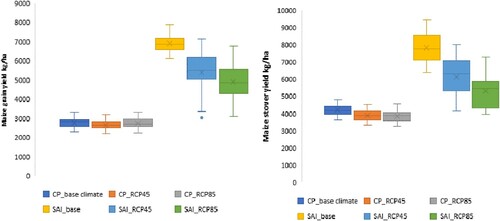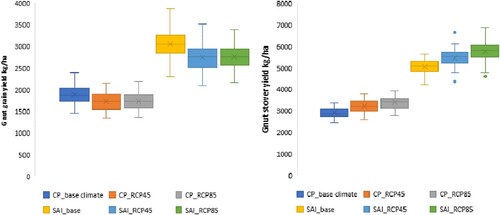ABSTRACT
One of the main drivers of deforestation in Zambia is the expansion of agricultural land for increasing production areas and for shift cultivation due to poor crop management practices. Land expansion was also echoed by farmers in Northwestern province as they aim to increase yield via land expansion. It was therefore important to understand possible associated socio-ecological trade-offs in agricultural extensification and identify pathways to improve ecosystem services delivery and reduce trade-offs. We used the Tradeoff Analysis model for Multi-Dimensional (TOA-MD) and Agricultural Production Systems Simulator (APSIM) to assess trade-offs in both current and future farming systems under extensification (CP) and sustainable agriculture intensification (SAI). Thirty-year simulations showed that agricultural extensification will lead to loss of soil organic carbon) and total soil nitrogen of about 23% and 22%, respectively leading to yield reductions of about 35% and increased poverty levels. However, SAI approach results showed that poverty can be reduced by about 20% for farmers with land holdings of 3 ha while those with 2 and 5 ha can be reduced by 10% and 5% respectively. The proposed SAI has potential to reduce poverty, maintain good current and future crop production, and potentially aid farmers to reduce opening new fields.
1 Introduction
Multifunctional agricultural landscapes in sub-Saharan Africa (SSA) are changing rapidly in response to various interrelated drivers such as increased demographic pressure and the development of local and urban markets resulting in a growing demand for food. These drivers in the context of climate change will place increased pressure on these systems to adapt. There is therefore need for action throughout the food system and one response has been the call to increase food production from existing farmland in ways that seek to reduce or eliminate negative environmental and social factors (Garnett et al., Citation2013; Haggar et al., Citation2017). This approach is sustainable agriculture intensification (SAI) which has been defined as producing more output from the same area of land while reducing the negative environmental impacts and at the same time increasing contributions to natural capital and the flow of environmental services (Pretty et al., Citation2011). SAI has also been described as practices that aim at increasing food production in response to demands of the growing population, reduce vulnerability to shocks and stresses while conserving critical ecological services (Musumba et al., Citation2017).
As much as the aim is to increase production efficiency, farmers and other stakeholders need to understand under what conditions agricultural inputs can either complement or contradict biological processes and ecosystem services (Pretty et al., Citation2011). These exchanges that occur as compromises or as trade-offs are ubiquitous when land is managed with multiple objectives (Klapwijk et al., Citation2014; Musumba et al., Citation2017). In multifunctional agricultural landscapes, trade-offs occur within agricultural systems, between agricultural and broader environmental or socio-cultural objectives, across time and spatial scales, and between actors (Klapwijk et al., Citation2014). It is therefore important to understand the systems dynamics that produce and alter the nature of trade-offs to achieve a sustainable and food secure future (Garnett et al., Citation2013; Klapwijk et al., Citation2014). This can be achieved through trade-off analysis. Trade-off analysis (TOA) is an approach for evaluating system level outcomes of agricultural production and prioritizing and targeting management interventions in multi-functional agricultural landscapes (van Wijk et al., Citation2016).
Several methods have been developed to analyse trade-offs, and widely applied approaches are participatory methods, empirical analyses, optimization models and simulation models (Klapwijk et al., Citation2014). Each of these approaches has its own strength and weaknesses, and combining approaches may provide enhanced opportunities for a realistic, relevant and integrated assessment system (van Wijk et al., Citation2016). For example, participatory approaches are needed to define meaningful objectives and indicators but are not suitable to reliably quantify the trade-offs associated with possible interventions (Musumba et al., Citation2017; van Wijk et al., Citation2016). On the other hand, empirical and econometric approaches can be used to quantify the current state of the overall agricultural systems, while simulation models would be important to quantify indicators that are difficult to measure and to explore options beyond the existing systems configurations and boundaries (van Wijk et al., Citation2016).
Of the several approaches mentioned above for trade-off analysis, we use empirical analysis and simulation modelling. Simulation modelling is important to quantify indicators that are difficult to measure and to explore options beyond the existing systems configurations and boundaries. Crop models such as APSIM, DSSAT, AquaCrop, have been developed to simulate biophysical processes in farming systems in relation to the economic and ecological outcomes of management practices in the face of climate risk ( Holzworth et al., Citation2015). APSIM, for example, has been an accessible tool for more than 20 years, for developing intervention strategies targeted at smallholder farmers in Africa under a wide range of management systems and conditions (Whitbread et al., Citation2010). Such models can be used with confidence in doing ex-ante analysis of alternative management strategies aimed at improving systems productivity also in the context of climate change. This is important for generating information that can be used to understand better under what conditions agricultural inputs can either complement or contradict biological processes and ecosystems services.
Although the government of Zambia through its Second Agriculture Policy supports sustainable agriculture, agriculture extensification is still widely practised in smallholder farming systems. It is therefore important to understand socio-ecological tradeoffs in agricultural extensification and identify pathways to improve ecosystems services delivery and reduce trade-offs. We used a combination of empirical analysis and simulation modelling to assess potential trade-offs under current agricultural management practices and identify pathways to improve synergies and reduce trade-offs.
2 Methodology
2.1 Study area
For a long time, the Northwestern has been one of the least populated provinces in Zambia, however, with opening of new copper mines there has been a high increase on population. Demand for food has increased as a result, and smallholder farmers particularly within the province are responding by opening new fields, abandoning old infertile ones and/or increasing sizes of existing ones. These practices exacerbate deforestation and land degradation hence detrimental effects for both current and future food production systems. Our study was done in Solwezi district, which saves as the province’s administrative headquarters. The district covers an area of about 30,261 km2 with a population of 25,4470, of which 3373 people above 12 years are usually working in the agriculture, hunting, forestry and fishing industry (Central Statistics Office, Citation2012).
Most of the people engaged in agriculture are small scale farmers who mostly depend on family members for farm labour, lowly mechanized, and generally do not use more than 5 ha for agricultural production each season. The major crops grown include maize, beans, cassava, potatoes and sweet potatoes. The major challenges for crop production include poor soil fertility exacerbated by soil acidity (acidic soils), mono cropping and shifting cultivation. Other challenges are poor road network to the market, expensive agro-inputs and low levels of mechanization. Besides crop production, farmers are also into small livestock (goat, sheep and village chicken) production and other off-farm activities such as charcoal burning and trading in various merchandises.
In the region, a greater proportion of farmers grow maize on larger fields in comparison to legumes and other crops. Yields for all major crops are generally low, maize yields are about 1500, groundnuts 600 and soya beans 800 kg/ha while attainable is >5000, 2000 and 2500 kg/ha, respectively. Low crop production is attributed to several factors with the main ones being high costs of inputs, low soil fertility and lack of available labour.
2.2 Household surveys
To get better understanding of farmer livelihoods in Solwezi, a household survey was done with total of 200 randomly selected farmers participating from 13 out of 55 agricultural camps. The survey collected data on general household information, farm characteristics, soil and water conservation practices, land cover and land use history, crop production, access to markets and agricultural information and household food security among others. Survey data was used for setting up crop modelling scenarios and defining farmer types for analysis in TOA-MD.
2.3 Participatory identification and prioritization of SAI practices
A participatory workshop was held with farmers, extension agents and other stakeholders (Masikati et al., Citation2018; Zimba et al., Citation2017), mainly for (i) identifying the vision of agriculture for farming communities, (ii) developing a prioritized list of Sustainable Agriculture Intensification (SAI) practices and (iii) identifying farmers willing to trial the SAI options on their farms. In the visioning exercises, farmers expressed their willingness to have a better future where they have improved houses, being able to send more children including girls to school, better modes of transport among others. Farmers highlighted that most of what they want in the future would be attained through increased agricultural production. This would mean increased farm sizes, use of improved management practices that include improved seeds, use of hybrid seeds, herbicides and pesticides.
Prioritized practices were crop rotation, conservation agriculture and integrated farming (). To assess potential impacts of prioritized SAI practices on crop production field experiments were established and 8 treatments included conservation agriculture practices that include rotations, minimum tillage, residue retention and agroforestry (Gliricidia-fertilizer tree) and different rates of fertilizer. For this paper, we only use data from four treatments across the sites as presented in .
Figure 1. Selected and ranked sustainable agriculture intensification practices by farmers in Solwezi.
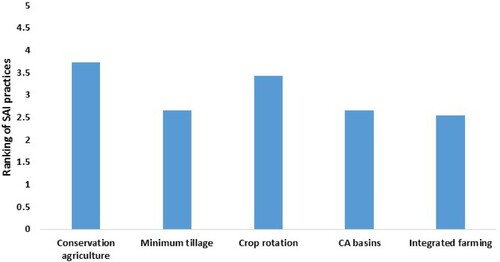
Table 1. Maize and groundnut treatments used for APSIM model calibration and application.
2.4 Crop modelling
For crop simulations, we used the Agricultural Production Systems Simulator (APSIM). APSIM is a model that has been developed to simulate biophysical processes in crop farming systems in relation to economic and ecological outcomes of management practices in current or future farming systems (Holzworth et al., Citation2015). The model has been used extensively in Africa and can be used with confidence to simulate maize cropping systems in Africa (Masikati et al., Citation2015; Whitbread et al. Citation2010). For Solwezi the model was evaluated using on-farm experimental data which were collected during the 2017/18 cropping season. Results were satisfactory, where Root Mean Square Error was 0.89 (http://landscapeportal.org/SairlaZambia/) and model was used with confidence to conduct prioritized SAI practices impact assessments on crop production. The model was used to assess impacts of current farmer practices and selected SAI practice () on soil organic carbon, soil total nitrogen and crop yields.
2.4.1 Crop management
In the APSIM model, planting was set to be done automatically after the model detected that the set soil moisture conditions were met. For this study, the sowing window was set between 15 November and 31 December, and planting was done when at least 15 mm of rain was received in 3 consecutive days. Outputs from APSIM, which were considered for the current analyses, include grain and stover yields for maize and groundnuts and soil organic carbon and total nitrogen. Treatments that were simulated included current farmer and SAI practices ()
2.4.2 Soils and climate
Soils information was obtained from household surveys and the Land Degradation Surveillance Framework (http://landscapeportal.org/SairlaZambia/). The best available historical weather record was gap filled with AgMERRA data to create a 30-year-long daily climate data set for simulations (Ruane & McDermid, Citation2017, Olivier Crespo from University of Cape Town provided climate data). To assess sensitivity of maize and groundnuts to different climatic factors: temperature (minimum and maximum), CO2 and rainfall we used two climate scenarios generated under two Representative Concentration Pathways (RCP), RCP4.5 and RCP8.5 for mid-century (2040–2070) (Ruane & McDermid, Citation2017). shows average base and future climate over 30 years. It shows clear change in terms of both maximum and minimum temperatures which show increases over the simulated periods.
2.5 TOA-MD model
To assess the impact of current and alternative SAI system, under different climate change scenarios and adaptation strategies, on livelihoods, we used the Tradeoff Analysis model for Multi-Dimensional impact assessment (TOA-MD) as ‘regional’ economic model (Antle, Citation2011). The TOA-MD model is a parsimonious, generic model for analysis of technology adoption and impact assessment of ecosystem services analysis (e.g. Valdivia et al., Citation2012) and climate change and adaptation impact assessments (Claessens et al., Citation2012). The TOA-MD model simulates technology adoption and impact in a population of heterogeneous farms. Farmers are assumed to be economically rational and to choose between systems based on expected economic returns. Primary survey data collected during the household surveys in Solwezi, together with secondary data (mostly for commodity and labour costing) were used to characterize the base systems (http://landscapeportal.org/SairlaZambia/). Characteristics of base system include farm types which in our case were mainly defined by farmland size, total livestock units and on-farm crop yields ().
Table 2. Farm types used in the evaluation of the farming system.
Crop simulations in APSIM were done for each household (200) that was surveyed, household farm outputs from the APSIM crop model, mainly crop yields across seasons were input into the TOA-MD model and used to assess the economic returns and poverty levels across farm populations. Realistic alternative technologies (based on participatory SAI practice prioritization and on-farm experiments) were assessed for their potential to improve the systems in general and as adaptation strategies to climate change.
3 Results and discussion
3.1 Maize grain and stover yield
Maize production was simulated using base and future (RCP45 and RCP85) climate under two treatments: current farmer practice (CP) and sustainable agriculture intensification (SAI). Crop yields (grain and stover) under the CP had lower yields than those under SAI practice for both current and future climate scenarios (). Although maize yields were lower under CP, variability and yield reductions were lower (less than 10%) than those simulated under SAI. Under SAI treatment yields were more than double the yields under farmer practice, however, variability was higher and there were substantial yield reductions of about 30% for both grain and stover under RCP85 scenario. Yield increases under SAI are attributed to crop residue retention (maize and groundnuts), nitrogen fixation from legume in rotation and biomass transfer from fertilizer trees (Gliricidia) among others. Although yields varied and reductions were higher under the SAI practice in future climates, generally the average yields were still higher than those obtained under CP.
Farmers highlighted that they wanted to increase their crop yields via increasing crop area. With current low ability to purchase extra inputs for the farm expansion, farmers could double their yields on existing croplands, using SAI approaches such as the one evaluated here.
Simulated yields under baseline climate for the CP treatment were within range of yields obtained from on-farm experiments of the 2017/18 season and national crop assessments also show that maize yields range between 2000 and 3000 kg/ha (Chapoto et al., Citation2018). The simulated yield reductions are mainly due to increased temperatures hence shortening crop growth period resulting in shorter time for biomass accumulation (Masikati et al., Citation2015) ().
3.2 Groundnuts
Simulated groundnut yields were also lower under the CP than under SAI practice. Increases under SAI could be attributed to improved crop variety, plant spacing, fertilizer application among others. Although grain yields were lower under the CP than SAI, yield reduction trends were similar where grain yields were reduced and stover yields increased under future climate scenarios. Grain yield reduction of about 10% was simulated for both CP and SAI while biomass increased by about 14% under RCP85. Groundnut stover yield increases under future climate scenarios are due to positive response to high CO2 levels, where base climate simulations used 361 ppm, RCP45 499 and RCP85 571 ppm. Increased groundnut biomass benefits the following cereal crop in rotation hence better synergies are projected for cereal-legume rotations in the future. Although increased future temperatures will also shorten crop growth period, the high response to CO2 negates the negative effect of high temperatures resulting in higher stover yields but lower grain yields ().
3.3 Soil organic carbon and total nitrogen
Soil organic carbon is important for both soil health and crop production, however, building soil health has always been a challenge for most smallholder farmers in Zambia hence practice of shifting cultivation. The use of inorganic fertilizers as promoted by the government through the Fertilizer Inputs Subsidies Program has not really helped the situation as evidenced by continued low yields across the country. The current national average fertilizer application rate is 35 kg N/ha (Zambia Agriculture Status Report, 2018) which is slightly higher than the application rate for Solwezi (28 kg N/ha). These application rates are higher than most in countries in the region where application rates range between 10 and 15 kg/ha (Gondwe & Nkonde, Citation2017). Although current fertilizer application rates in Zambia are better than elsewhere in the region, simulation done under both current and future climate show that yields will reduce in the long term. This is mainly due to mono cropping systems and non-retention of quality crop residues. This will cause both soil organic carbon (SOC) and total nitrogen (TN) to reduce over time and so will the crop yields ().
Figure 6. Simulated soil organic carbon and total nitrogen gains and losses for current farmer practice (CP) and sustainable agriculture intensification (SAI) practice under base and future climate RCP45 and RCP85.
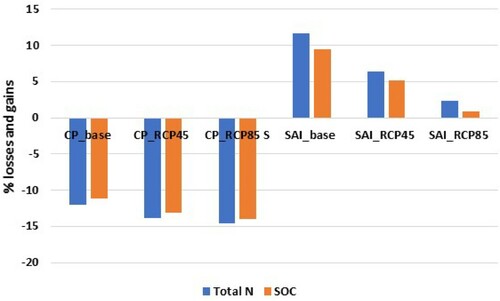
Simulations showed that SOC and TN reduction will be exacerbated by climate change, mainly due to temperature increases which will increase turnover of organic matter. Reduction of about 15% was simulated under CRP85 for the current farmer practice (). However, with the SAI practice, using base climate gains of more than 10% were simulated while for RCP45 and RCP85 were 5% and 3.5%, respectively. SAI practices would be important in the future for maintaining both soil health, crop production and household incomes. There are no long-term field experiments to confirm these levels of losses or gains of SOC and TN, however the simulated losses under current farming practices are similar to those reported by Sanchez et al. (Citation1997) who reported annual N losses of up to 660 kg/hain a period of about 30 years from an estimated 200 million ha of cultivated land in 37 African countries. In our study simulations showed that farmers in Solwezi could lose about 473 and 645 kg/ha under current practice for current and future climate, respectively.
3.4 Simulated socio-economic impacts
Here the TOA-MD model was used to assess impacts of current farmer production and sustainable agriculture intensification practices on farm socio-economics. Surveyed farming households were stratified using the typology technique based on Ward Cluster Analysis methodology. Three farm types which were mainly differentiated by farm size, TLU and crop yields were used to assess impacts of FP and SAI on farm net returns, intervention adoption rates and poverty levels.
Evaluation of net farm returns and how they changed under FP and SAI in the face of climate change indicates that under base climate SAI increased benefits and net farm returns. Under future climate (both RCP45 and RCP85), SAI shows negative impacts and decreases the net returns. Although there are projected net return decreases under SAI for future climate, simulations showed high adoption rates of about 66.4%. High levels of adoption and poverty reductions from 84.3% to 70.5%. When evaluated the SAI practice showed potential to double the net farm returns from 600 to 1200 US dollars on aggregate for farm type 1 (<2 ha) while for farm type 2 (3 ha) from 1300 to 2000 dollars ().
Figure 7. Net farm returns across farm types under base climate, RCP4.5 and 8.5 crop management and climate scenarios. Farm types 1, 2 and 3 represent farm sizes of 2, 5 and 3 ha, respectively. CP_ = current farmer practice without climate change and SAI_ = Sustainable agriculture intensification practice.
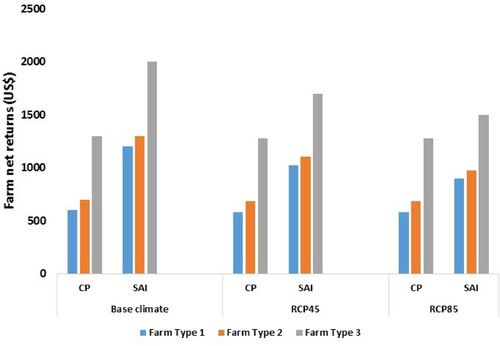
3.5 Socio-ecological trade-offs
Sustainable agriculture intensification has been defined as producing more output from the same area of land while reducing the negative environmental impacts and at the same time increasing contributions to natural capital and the flow of environmental services (Pretty et al., Citation2011). However, farmers from Solwezi district, North Western Province of Zambia believe that they can increase production by increasing their land sizes versus intensifying.
On socio-economic domain, results showed that current production practices will not reduce poverty levels and these levels will be exacerbated by climate change. However, if farmers would adopt sustainable agricultural practices such as low application of inorganic fertilizer (28 kg N/ha), plus fertilizer tree biomass transfer and rotations with residue retention, poverty levels will reduce by about 20% for farmers with average sized farms (3.3 ha) and about 10% for those with smaller farm sizes (<2 ha). However, those with larger farms (>5 ha) will not make much of a difference with and without climate change, 84.5% and 87.0% poverty rates, respectively (). In the Solwezi situation, larger farms (>3 ha) would demand more labour which farmers currently do not have, as most agriculture activities are manual. Using current farmer practices (CP) simulated crop production under future climate shows that about 90% of households in Farm types 1 and 2 (biggest and smallest farms) will be in poverty under both RCP45 and RCP85. Current poverty levels in the rural areas are at 83%. Simulation results showed that SAI has potential to reduce poverty to about 60% on average farm sizes, this reduction is still low hence importance to diversify. Data from Machakos in Kenya showed that households that had income from dairy production had poverty about 50% lower than households that depend primarily on crops (Valdivia et al., Citation2017)
Figure 8. Poverty levels across farm types, crop management and climate scenarios. Farm types 1, 2 and 3 represent farm sizes of 2, 5 and 3 ha, respectively. CP_No CC = current farmer practice without climate change, CP_With CC = current farmer practice with climate change, SAI_No CC = Sustainable agriculture intensification practice without climate change, SAI_With CC = Sustainable agriculture intensification with climate change.

On the environmental and crop productivity domains, simulations of 30 years showed that over time total soil nitrogen, organic carbon and maize yields (grain and stover) will reduce under both current and future climate. Reductions were more pronounced under future climate hence potential of increased food shortages. However, the adoption of SAI practices showed that in the current climate both soil and crop productivity can be increased. For future climate, soil fertility showed 67 increases under low emission scenario while smaller increases were simulated for the high emission scenario (). Although increases are small both SOC and TN levels will not be lower than the current levels. This shows that SAI practices have potential to increase soil fertility, crop productivity and reduce poverty rates on average land sizes where adequate labour can be provided. Soils under SAI practices will have potential to buffer negative climate effects on crop production (Masikati et al., Citation2019). However, simulated decline of SOC and TN under current farmer practices also entails decrease in crop yields, hence increase in future poverty levels if farmers continue using the same practices. Valdivia et al. (Citation2017) showed that there was a correlation between poverty and soil nutrient loss, as system productivity reduces also will income reduce leading to increased poverty.
Figure 9. Simulated relations between maize yield and soil organic carbon (a–b) and total nitrogen (c–d) across different practices and climate scenarios. The different coloured dots represent yearly averages across thirty years while the black circle represents levels at the start of the simulation. CP = Farmer current practice, SAI = Sustainable agriculture intensification practice, Base = base climate, RCP45 low emission climate, RCP85 = high emission climate, SOC = soil organic carbon, TN + total soil nitrogen.
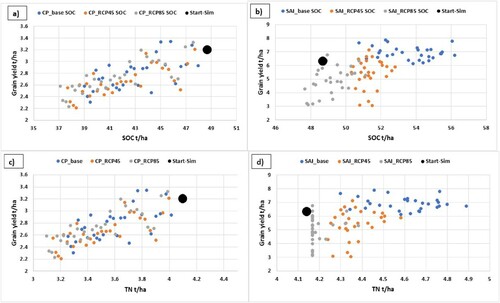
4 Conclusion
Opening of new fields aimed at increasing yields by most farmers in Zambia is substantially contributing to the 250,000 ha deforested annually (Matakala et al., Citation2015; Vinya et al., Citation2011). During a participatory SAI practice prioritizing workshop, farmers in Solwezi proposed having larger croplands to increase their production and improve livelihoods. We used a combination of approaches to uncover socio-ecological tradeoffs in agricultural extensification and identify pathways to improve ecosystems services delivery and reduce trade-offs. There are socio-ecological trade-offs associated with extensification in current agricultural systems, and these include cost on environmental health as evidenced by simulated soil nutrient loss and decreased system productivity leading to reduced on-farm income and increased poverty levels. From the current study, aspired crop yields can be attained on current cropland sizes by using sustainable intensification practice such as crop rotations plus fertilizer tree biomass transfer. The SAI practice evaluated here has potential to increase soil organic carbon and total nitrogen over time under varying climate conditions. Currently the government is subsidizing inorganic fertilizers, if these efforts could be coupled with SAI practices crop yields and soil fertility could be increased. This can potentially contribute to reduced clearance of new croplands aimed at increasing production. Although the adoption of the SAI practice would increase yields, soil fertility and farm net returns, poverty levels will still be high and climate change will have additional negative impacts. It is therefore important to look at alternative livelihoods rather than just crop production.
Acknowledgments
The study uses farming systems data obtained through the DFID Sustainable Agriculture Intensification Research and Learning in Africa (SAIRLA) project. Links were also established with the CGIAR-WLE and FTA through provision of publishing funds. Authors are also grateful to Solwezi communities and Ministry of Agriculture in particular the Zambia Agriculture Research Institute and St. Francis And Mutanda Agriculture Block officers (Mr Mwansa and Mrs Hachobe) in Solwezi for their collaboration on establishing experimental sites and data collection.
Disclosure statement
No potential conflict of interest was reported by the author(s).
Correction Statement
This article has been republished with minor changes. These changes do not impact the academic content of the article.
Additional information
Funding
Notes on contributors
Patricia Masikati
Dr Patricia Masikati is a Systems Scientist at World Agroforestry (ICRAF based in Lusaka Zambia. She has over 20 years of experience working in smallholder farming systems of Africa on key issues around sustainable agriculture intensification and systems modelling.
Givious Sisito
Mr Givious Sisito is a Senior Research Officer at Matopos Research Institute based in Matopos, Zimbabwe. He has substantial experience in smallholder farming systems of Southern Africa and specializes in data analysis and economic modelling.
Floyd Chipatela
Mr Floyd Chipatela is a Senior Agriculture Research Officer at Zambia Agriculture Research Institute based in Solwezi, Zambia. He is an agronomist by training and specializes in training farmers, extension officers and other stakeholders on good agricultural practices and disseminating research information.
Howard Tembo
Mr Howard Tembo is a Chief Agriculture Research Officer at Zambia Agriculture Research Institute based in Lusaka, Zambia. He has over 40 experience in agriculture and agroforestry research in smallholder farming systems of Zambia and in charge of dissemination agriculture information across the country.
Leigh Ann Winowiecki
Dr Leigh Ann Winowiecki is a Soil Systems Scientist at World Agroforestry (ICRAF) based in Nairobi, Kenya. She has over 15 years of experience working in the global tropics on key issues around land restoration, sustainable agricultural intensification and soil carbon dynamics.
References
- Akinnifesi, F. K., Ajayi, O. C., Sileshi, G., Chirwa, P. W., & Chianu, J. (2010). Fertiliser trees for sustainable food security in the maize-based production systems of East and Southern Africa. A review . Agronomy for Sustainable Development, 30, 615–629. https://doi.org/https://doi.org/10.1051/agro/2009058
- Antle, J. (2011). Parsimonious multi-dimensional impact assessment. American Journal of Agricultural Economics, 93(5), 1292–1311. https://doi.org/https://doi.org/10.1093/ajae/aar052
- Central Statistics Office. (2012). National analytical report: 2010 census of population and housing. Central Statistical Office. www.zamstats.gov.zm
- Chapoto, A., Chisanga, B., & Kabisa, M. (2018). Zambia Agriculture Status Report 2018. Indaba Agricultural Policy Research Institute Lusaka, Zambia.
- Claessens, L., Antle, J. M., Stoorvogel, J. J., Valdivia, R. O., Thornton, P. K., & Herrero, M. (2012). A method for evaluating climate change adaptation strategies for small-scale farmers using survey, experimental and modeled data. Agriculture Systems, 111, 85–95. https://doi.org/https://doi.org/10.1016/j.agsy.2012.05.003
- Garnett, T., Appleby, M. C., Balmford, A., Bateman, I. J., Benton, T. G., Bloomer, P., Burlingame, B., Dawkins, M., Dolan, L., Fraser, D., Herrero, M., Hoffmann, I., Smith, P., Thornton, P. K., Toulmin, C., Vemuelen, S. J., & Godfray, H. C. J. (2013). Sustainable intensification in agriculture: Premises and policies. Science, 341(6141), 33–34. https://doi.org/https://doi.org/10.1126/science.1234485
- Gondwe, B., & Nkonde, D. (2017). Optimizing fertilizer use within the context of integrated soil fertility management in Zambia. In C. S. Wortman & K. Sones (Eds.), Fertilizer use optimization in Sub-Saharan Africa (pp. 210–221). CAB International.
- Haggar, J., Soto, G., Casanoves, F., & de Melo Virginio, E. (2017). Environmental-economic benefits and trade-offs on sustainably certified coffee farms.
- Holzworth, D., Huth, N. I., Fainges, J., Herrmann, N. I., Zurcher, E., Brown, H., Snow, V., Verral, S., Cichota, R., Doherty, A., deVoil, P., McLean, G., & Brider, J.. (2015, November 29–December 4). APSIM next generation: The final frontier. In T. Weber, M. J. McPhee, & R. S. Anderssen (Eds.), MODSIM2015, 21st International congress on Modelling and Simulation. Modelling and Simulation Society of Australia and New Zealand (pp. 490–496). ISBN 978-0-9872143-5-5. www.mssanz.org.au/modsim2015/B4/walmsley.pdf
- Klapwijk, C. J., van Wijk, M. T., Rosenstock, T. S., van Asten, P. J. A., Thornton, P. K., & Giller, K. E. (2014). Analysis of trade-offs in agricultural systems: current status and way forward. Current opinion in Environmental Sustainability.
- Masikati, P., Chipatela, F., Mwansa, C., Patamu, R., Magaju, C., Winowiecki, L., Bourne, M., & Neely, C. (2018). Participatory assessment of socio-ecological tradeoffs of SAI practices in solwezi. Bringing evidence to bear of negotiating ecosystem service and livelihood trade-offs in sustainable agricultural intensification (p. 22). World Agroforestry Centre (ICRAF).
- Masikati, P., Descheemaeker, K., & Crespo, O. (2019). Understanding the role of soils and management on crops in the face of climate uncertainty in Zimbabwe: A sensitivity analysis. In T. Rosenstock, A. Nowak, & E. Girvetz (Eds.), The climate-smart agriculture papers (pp. 49–64). Springer.
- Masikati, P., Homann-KeeTui, S., Descheemaeker, K., Crespo, O., Walker, S., Lennard, C. J., Claessens, L., Gama, A. C., Famba, S., van Rooyen, A. F., & Valdivia, R. O. (2015). Crop-livestock intensification in the face of climate change: Exploring opportunities to reduce risk and increase resilience in Southern Africa using an integrated multi-modeling approach. In C. Rosenzweig & D. Hillel (Eds.), Handbook of climate change and agroecosystems: The agricultural model intercomparison and improvement project (AgMIP) integrated crop and economic assessments, ICP series on climate change impacts, adaptation, and mitigation (Vol. 3, pp. 90–112). Imperial College Press.
- Matakala, P. W., Kokwe, M., & Statz, J. (2015). Zambia national strategy to reduce emissions from deforestation and forest degradation (REDD+). UN-REDD programme.
- Musumba, M., Grabowski, P., Palm, C., & Snapp, S. (2017). Guide for the Sustainable Intensification Assessment Framework. 46 pgs.
- Pretty, J., Toulmin, C., & Williams, S. (2011). Sustainable intensification in African agriculture. International Journal of Agricultural Sustainability, 9(1), 5–24. https://doi.org/https://doi.org/10.3763/ijas.2010.0583
- Ruane, A. C., & McDermid, S. P. (2017). Selection of a representative subset of global climate models that captures the profile of regional changes for integrated climate impacts assessment. Earth Perspect, 4, 1. https://doi.org/https://doi.org/10.1186/s40322-017-0036-4
- Sanchez, P. A., Shepherd, K. D., Soule, M. J., Place, F. M., Buresh, R. J., Izac, A. M. N., Mokwunye, A. U., Kwesiga, F. R., Ndiritu, C. G., & Woomer, P. L. (1997). Soil fertility replenishment in Africa: An investment in natural resource capital. In R. J. Buresh, P. A. Sanchez, & F. Calhoun (Eds.), Replenishing soil fertility in Africa, SSSA special publication 51 (Pp. 1–46). Soil Science Society of America.
- Valdivia, R. O., Antle, J. M., & Stoorvogel, J. J. (2012). Coupling the tradeoff analysis model with market equilibrium model to analyze economic and environmental outcomes of agricultural production systems. Agricultural Systems, 110, 17–29. https://doi.org/https://doi.org/10.1016/j.agsy.2012.03.003
- Valdivia, R. O., Antle, J. M., & Stoorvogel, J. J. (2017). Designing and evaluating sustainable development pathways for semi-subsistence crop-livestock systems: Lessons from Kenya. Agricultural Economics, 48(S1), 11–26. https://doi.org/https://doi.org/10.1111/agec.12383
- van Wijk, M. T., Klapwijk, C. J., Rosenstock, T. S., van Asten, P. J. A., Thornton, P. K., & Giller, K. E. (2016). Methods for environment: Productivity trade-off analysis in agricultural systems. In T. Rosenstock, M. Rufino, K. Butterbach-Bahl, L. Wollenberg, & M. Richards (Eds.), Methods for measuring greenhouse gas balances and evaluating mitigation options in smallholder agriculture (pp. 189–198). Springer. https://doi.org/https://doi.org/10.1007/978-3-319-29794-1_10
- Vinya, R., Syampungani, S., Kasumu, E. C., Monde, C., & Kasubika, R. (2011). Preliminary Study on the Drivers of Deforestation and Potential for REDD+ in Zambia. A consultancy report prepared for Forestry Department and FAO under the national UN-REDD+ Programme Ministry of Lands & Natural Resources. Lusaka, Zambia.
- Whitbread, A. M., Robertson, M. J., Carberry, P. S., & Dimes, J. P. (2010). How farming systems simulation can aid the development of more sustainable smallholder farming systems in Southern Africa. European Journal of Agronomy, 32(1), 51–58. https://doi.org/https://doi.org/10.1016/j.eja.2009.05.004
- Zimba, K., Mtonga, E., Masikati, P., Chaponda, C. M., & Hachoobe, R. P. (2017). Participatory Identification of Prioritized SAI Practices and Indicators of Success in Solwezi District, Zambia (St. Francis and Mutanda Camps), 1–2 March 2017. Workshop report. World Agroforestry Centre (ICRAF), Kenya.



